In between a hectic project schedule, I have also committed myself to a reading list of books, the first half of 2018 is already behind me (can’t believe!) and I’m just letting myself wade through this hot summer with some practical knowledge books. I am already through a few titles and I am attempting to get that number up with some interesting non-fiction titles lined up for the latter half of 2018, so fingers crossed. I only decided to read about design so far, but now I’m accessing titles on communications, psychology, strategy, business and marketing. My overarching goal from reading the books is to broaden my vision of how I could commit to my long-term objective of merging creativity with building a value proposition for products while staying focused on service innovation & customer experience. Lastly, instead of doing an annual review/recommendation of books I decided to write a post as soon as I finish some volumes just so that I get my views out to the world quickly. Which also helps me to remember the value of my reading list and the freshness of the knowledge I gain each year.
The Business of Design: Balancing Creativity and Profitability (by Keith Granet)
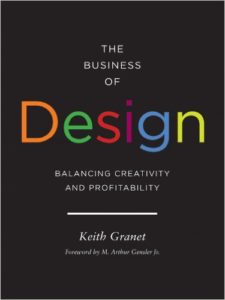 Even though the target audience for this book seemed like the architects and interior designers, this book didn’t disappoint me so far as comprehending the principles of business were concerned. Keith Granet brings his insights from his experience of 30 years from bringing profitability to customers and setting up his architecture design firm Granet & Associates from spending considerable time on projects as a full-time employee. There are some terms and details which could be only be comprehended by someone from that industry, like for instance, the promotion cycles for employees or the contractual obligations for clients, etc., but despite that seemingly nonessential information, the rest of the principles in the book from billing and human resources, to managing a team, stay pretty much relevant as foundations for setting up any business. In the end, this book is profound and inspirational in its approach towards design entrepreneurship, even if you don’t plan to work as an architect or an interior design.
Even though the target audience for this book seemed like the architects and interior designers, this book didn’t disappoint me so far as comprehending the principles of business were concerned. Keith Granet brings his insights from his experience of 30 years from bringing profitability to customers and setting up his architecture design firm Granet & Associates from spending considerable time on projects as a full-time employee. There are some terms and details which could be only be comprehended by someone from that industry, like for instance, the promotion cycles for employees or the contractual obligations for clients, etc., but despite that seemingly nonessential information, the rest of the principles in the book from billing and human resources, to managing a team, stay pretty much relevant as foundations for setting up any business. In the end, this book is profound and inspirational in its approach towards design entrepreneurship, even if you don’t plan to work as an architect or an interior design.
The Design of Everyday Things: Revised and Expanded Edition (by Don Norman)
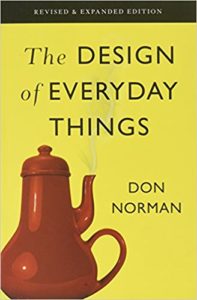 This is a bestseller and a must-have on your reading list if you’re in the business of interaction design, in general. I picked its first edition about a decade ago and couldn’t put it down – it was first published as the Psychology of Everyday Things or POET for short, so when I came across this revised and expanded edition on the bookshelves I was tempted to go for it again. This edition looks at human interaction from the perspective of newer innovations such as the touch-based technology and uncovers the principles of user-experience design. The factors that enhance the desirability of a product like building comprehensive affordances and signifiers in the interfaces while providing for natural mapping makes it easier and faster for the user to put it to good use without the need of a manual. It was also tempting to pick this newer publication because it also consists of a whole chapter on Design Thinking and human-centred design. Also, it’s important to note that there are tons of interesting real-life instance from Don Norman’s experience which relate to the psychology of common things and the usability engineering of products overall. I was happy that just as technology has moved and influenced our culture of working with devices, this book too, has documented those relevant changes and presented it in an easy-to-read format. Needless to say, it has become a bestseller and an iconic book for designers and psychologists alike.
This is a bestseller and a must-have on your reading list if you’re in the business of interaction design, in general. I picked its first edition about a decade ago and couldn’t put it down – it was first published as the Psychology of Everyday Things or POET for short, so when I came across this revised and expanded edition on the bookshelves I was tempted to go for it again. This edition looks at human interaction from the perspective of newer innovations such as the touch-based technology and uncovers the principles of user-experience design. The factors that enhance the desirability of a product like building comprehensive affordances and signifiers in the interfaces while providing for natural mapping makes it easier and faster for the user to put it to good use without the need of a manual. It was also tempting to pick this newer publication because it also consists of a whole chapter on Design Thinking and human-centred design. Also, it’s important to note that there are tons of interesting real-life instance from Don Norman’s experience which relate to the psychology of common things and the usability engineering of products overall. I was happy that just as technology has moved and influenced our culture of working with devices, this book too, has documented those relevant changes and presented it in an easy-to-read format. Needless to say, it has become a bestseller and an iconic book for designers and psychologists alike.
This is Service Design Thinking: Basics, Tools, Cases (by Marc Stickdorn and Jakob Schneider)
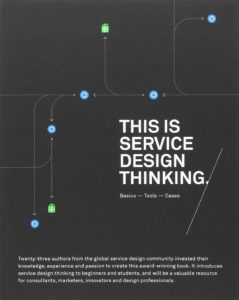 Lately, I have begun working towards service design and leaning more towards enhancing the services that a customer could be offered through a sales cycle. This basically translates into designing experiences in & around the intangible needs of the customer so I couldn’t have picked this book at a more opportune time that deals with this methodology in a much comprehensive way. The volume is conveniently divided into 3 sections – Basics, Tools and the Case Studies, taking the reader through the methodology and thinking patterns provided by a bevvy of industry experts. Beginning with the importance of service-related design in the new-age information economy, where the customer’s first touchpoint to access the product is rarely the store outlet. I found the section which deals with the various tools for service design quite insightful, although it’d make more sense to read as well as practice it as a team in implementing it. Furthermore, the book defines the extent to which a service design thinking methodology would play a crucial role in the innovation of features and products through the case studies. But here’s the catch, you might find reading the high-grade language a bit discomforting. I’d have preferred a book that explains the context not just visually (which this book does in oodles) but also accompanying it with simple writing. Apart from that, the presentation of the volume is marvellous and you might look at keeping this in your personal book library or just your reading list as a reference. On that note, this book also has a supporting volume called This Is Service Design Doing which carries practical co-creation techniques & tools to run a service design project or workshop also vividly discussed in This Is Service Design Thinking.
Lately, I have begun working towards service design and leaning more towards enhancing the services that a customer could be offered through a sales cycle. This basically translates into designing experiences in & around the intangible needs of the customer so I couldn’t have picked this book at a more opportune time that deals with this methodology in a much comprehensive way. The volume is conveniently divided into 3 sections – Basics, Tools and the Case Studies, taking the reader through the methodology and thinking patterns provided by a bevvy of industry experts. Beginning with the importance of service-related design in the new-age information economy, where the customer’s first touchpoint to access the product is rarely the store outlet. I found the section which deals with the various tools for service design quite insightful, although it’d make more sense to read as well as practice it as a team in implementing it. Furthermore, the book defines the extent to which a service design thinking methodology would play a crucial role in the innovation of features and products through the case studies. But here’s the catch, you might find reading the high-grade language a bit discomforting. I’d have preferred a book that explains the context not just visually (which this book does in oodles) but also accompanying it with simple writing. Apart from that, the presentation of the volume is marvellous and you might look at keeping this in your personal book library or just your reading list as a reference. On that note, this book also has a supporting volume called This Is Service Design Doing which carries practical co-creation techniques & tools to run a service design project or workshop also vividly discussed in This Is Service Design Thinking.
Changing the Conversation: The 17 Principles of Conflict Resolution (by Dana Caspersen)
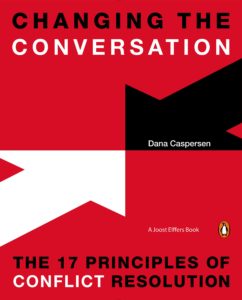 This book was definitely off-topic if you considered the other titles from my reading list that were solely concerned with design or the likes of it. But I truly found Changing the Conversation as a welcome break from the limitless design knowledge I had been gathering, in that, it was closely related to a complex situation arising out of a poor display of emotions or generally, choice of words. As the title suggests, the book is spread over 17 principles and as many chapters and each chapter begins first by explaining an ‘anti principle’ (coloured red) and a corresponding ‘principle (coloured in black). The author shares stories from real-life scenarios and in simple terms with exercises to practice at the end of every section to drive home the point of maintaining your interest and curiosity in the face of a difficult situation, about creating a dialogue and not letting the difficulty fester into so. ‘Conflict’ could be seen as a destructive pattern or it could be explored as an opportunity for moving towards more positive outcomes. It was so much fun reading this book that I finished it in 2 days flat! And because you could correlate this book with any of the other titles from my reading list it would make sense to pick up something that relates directly to conflict resolution within your team.
This book was definitely off-topic if you considered the other titles from my reading list that were solely concerned with design or the likes of it. But I truly found Changing the Conversation as a welcome break from the limitless design knowledge I had been gathering, in that, it was closely related to a complex situation arising out of a poor display of emotions or generally, choice of words. As the title suggests, the book is spread over 17 principles and as many chapters and each chapter begins first by explaining an ‘anti principle’ (coloured red) and a corresponding ‘principle (coloured in black). The author shares stories from real-life scenarios and in simple terms with exercises to practice at the end of every section to drive home the point of maintaining your interest and curiosity in the face of a difficult situation, about creating a dialogue and not letting the difficulty fester into so. ‘Conflict’ could be seen as a destructive pattern or it could be explored as an opportunity for moving towards more positive outcomes. It was so much fun reading this book that I finished it in 2 days flat! And because you could correlate this book with any of the other titles from my reading list it would make sense to pick up something that relates directly to conflict resolution within your team.
The Industries of The Future (by Alec Ross)
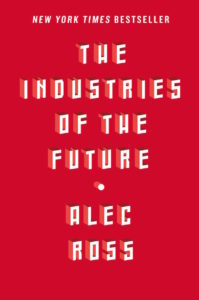 I have always believed in the mantra that the consumer of your product has a bigger role in deciding its future. While also being aware that they are located at the demanding intersection of design and technology, and luckily for me, I get to balance their needs from a customer experience/service design standpoint by putting their needs at the forefront of building value. That also means that I have to keep track of what’s coming next in the digital transformation journey in order to support their underlying cause of solving their problems. If it’s predictive AI or VR today it might be robotics tomorrow, how might these tech opportunities help the consumers and how could we merge them with ‘user-centred design’? While this book did not provide any direct answers in that respect it did help me understand what the future looks like in, say, 2050, and the industries which would be transformed completely.
I have always believed in the mantra that the consumer of your product has a bigger role in deciding its future. While also being aware that they are located at the demanding intersection of design and technology, and luckily for me, I get to balance their needs from a customer experience/service design standpoint by putting their needs at the forefront of building value. That also means that I have to keep track of what’s coming next in the digital transformation journey in order to support their underlying cause of solving their problems. If it’s predictive AI or VR today it might be robotics tomorrow, how might these tech opportunities help the consumers and how could we merge them with ‘user-centred design’? While this book did not provide any direct answers in that respect it did help me understand what the future looks like in, say, 2050, and the industries which would be transformed completely.
Emotional Design: Why We Love (or Hate) Everyday Things (by Don Norman)
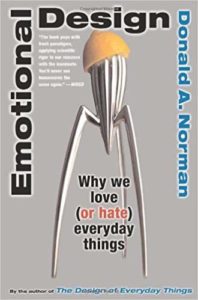 I picked this book after ages to refresh my taste in user-experience. This title, indeed, is a comprehensive treatise on the topic of user-centred design and a guide for anyone starting his/her journey into the fascinating world of UX. In a nutshell, the book deep dives into the basic tenet of UX, the three levels of design as defined by Norman, which starts with the study of the human psychology, how each individual would react to certain visceral feelings and adapt to specific conditions behaviourally while recording the events in the reflective centres of the brain for future use. As the title suggests, the subtext of this book deals with the value of emotions in design, because unless the emotional needs of the consumers are considered the perceived usability of a product isn’t going to be appreciated in the long term. However, in my opinion, the author went overboard with his relentless discussion of robots in the second half of the book but it’s still useful to read Don Norman’s amazing piece.
I picked this book after ages to refresh my taste in user-experience. This title, indeed, is a comprehensive treatise on the topic of user-centred design and a guide for anyone starting his/her journey into the fascinating world of UX. In a nutshell, the book deep dives into the basic tenet of UX, the three levels of design as defined by Norman, which starts with the study of the human psychology, how each individual would react to certain visceral feelings and adapt to specific conditions behaviourally while recording the events in the reflective centres of the brain for future use. As the title suggests, the subtext of this book deals with the value of emotions in design, because unless the emotional needs of the consumers are considered the perceived usability of a product isn’t going to be appreciated in the long term. However, in my opinion, the author went overboard with his relentless discussion of robots in the second half of the book but it’s still useful to read Don Norman’s amazing piece.
Thankfully, this isn’t the end of my reading list, and I am hoping to get through a few more titles before the end of 2018!


